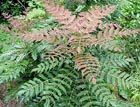Make Way for a Mahonia Boom
Maturity does great things to gardners, including allowing them to mellow towards the prickly Mahonia.


As an apprentice, I had much the same feelings about the many varieties of Mahonia as I experience when, trapped on the Tube, I glance at a neighbour's celebrity magazine: I don't know any of these characters, and I can't say that I care. My Mahonia prejudice began early on when one nurseryman required me to clean and label fields of the spiny blighters-I'd have sooner been sent up chimneys.But maturity does great things to gardeners, among them learning to forgive, or even to relish, a Mahonia's prickliness just as one would in a curmudgeonly but constant friend. In the garden, as at the table or in the concert hall, an acquired taste is often the most deeply cherished.These days, I'd find winter harder to face without the uplifting, lily-of-the-valley effusions of M. japonica.
Nor would I do without the verve of M. x media - fast-growing, free-flowering with towering stems, wondrously wheeling foliage and blooms held high in golden diadems. Latterly I have even been making room for the American M. aquifolium, popularly known as the Oregon grape (from its bloomy acidulous fruit). This was the first species to be named Mahonia, in 1818, to commemorate the enterprising US nurseryman Bernard McMahon who had died two years earlier.So good is it at covering inhospitable ground, that landscapers have fallen upon the Oregon grape and squeezed it until the pips squeak. We are too familiar with it to love it.
Only look more closely at some of the better cultivars of M. aquifolium, and you will discover shrubs of unparalleled value. Try Apollo, for example, with leaves that turn with cold to nacreous plum; Orange Flame with winter growth of exactly the same cheeringly opulent hue as a package from Hermes; or my own favourite, Smaragd, which faces down the chill by colouring its foliage in shining copper.We are in the midst of a Mahonia boom in which the rarer cousins of these better-known shrubs mare becoming available for the first time. Far from being commonplace, these newcomers are collectible.
At Crug Farm Plants in North Wales, for example, indefatigable plant hunters Bleddyn and Sue Wynn-Jones are now offering M. oiwakensis, which they introduced from Taiwan in 1996. With 3ft-long leaves and sprawling, starfish-like heads of nankeen-yellow flowers in autumn and early winter, this giant looks spectacular when grown with bamboos such as Phyllostachys and hardy palms such as Trachycarpus fortunei ; it is a marvellous beast to let loose in domestic jungles.
If I have to take sides in the Mahonia incursion, I must declare myself a Lancastrian. Although any plant introduced to cultivation by Roy Lancaster is worth growing, two small and graceful Mahonia stand out. He discovered them in 1980 in a shady ravine on Emei Shan, China's great western sacred mountain.One is M. confuse, with feathery crowns of slender leaves that shift from bronze to aquamarine, and autumnal tufts of tawny flowers. The other is M. gracilipes with broader, darker leaflets that run along cinnabar stalks and flicker in high winds to reveal undersides of brilliant white. Uniquely for a Mahonia, the flowers of this second species are not yellow but contrasting claret and cream, and they appear with reckless prodigality from late summer onwards. In the 1980s, these two plants, so long separated by just yards of Chinese gulley, met at The Savill Garden in Windsor. The result of their encounter is M. x savilliana, a hybrid that is sturdier than either parent (both of which like a somewhat sheltered site) with slim battleship grey fronds and crème brulée blooms.
Plantsmanship is often a matter of patience and percolation. It can take an age for sensational introductions like these to come within our grasp. This is why I talk about something that happened a quarter of a century ago as if it were news. And Mr Lancaster's Mahonia have certainly been making headlines in our garden this winter. We deployed all three of them (the hybrid included) in different locations, each playing the starring role in ensembles of elegant evergreens such as the sweetly scented Sarcococca Dragon Gate (another Lancaster discovery), Nandina domestica and the fan-leaved Iris confuse.
This article first appeared in COUNTRY LIFE magazine on January 4, 2006
Exquisite houses, the beauty of Nature, and how to get the most from your life, straight to your inbox.
Country Life is unlike any other magazine: the only glossy weekly on the newsstand and the only magazine that has been guest-edited by His Majesty The King not once, but twice. It is a celebration of modern rural life and all its diverse joys and pleasures — that was first published in Queen Victoria's Diamond Jubilee year. Our eclectic mixture of witty and informative content — from the most up-to-date property news and commentary and a coveted glimpse inside some of the UK's best houses and gardens, to gardening, the arts and interior design, written by experts in their field — still cannot be found in print or online, anywhere else.
